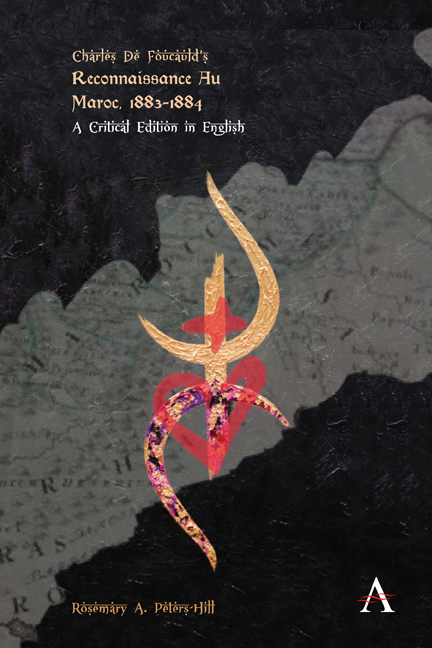Book contents
- Frontmatter
- Contents
- List of Figures
- Acknowledgments
- “There are no roads”: Charles de Foucauld’s Reconnaissance au Maroc—a Critical Introduction
- Charles de Foucauld, Reconnaissance au Maroc, 1883–1884
- Letter to François de Bondy
- Introduction
- Avant-Propos
- I Tangiers to Meknès
- II Meknès to Qaçba Beni Mellal
- III Qaçba Beni Mellal to Tikirt
- IV Tikirt to Tissint
- V Sojourn in the Sahara
- VI Tissint to Mogador
- VII Mogador to Tissint
- VIII Tissint to the Dadès
- IX The Dadès to Qçabi ech Cheurfa
- X Qçabi ech Chorfa to Lalla Maghnia
- Appendix: The Jews of Morocco
- Note on the Materials Used to Draw Up My Itinerary
- Report Delivered to the Société de Géographie de Paris in Its General Session of 24 April 1885
- “Itineraries in Morocco”
- Afterwards: An Afterword
- Glossary of Terms
- Bibliography
- Index
IV - Tikirt to Tissint
Published online by Cambridge University Press: 20 January 2022
- Frontmatter
- Contents
- List of Figures
- Acknowledgments
- “There are no roads”: Charles de Foucauld’s Reconnaissance au Maroc—a Critical Introduction
- Charles de Foucauld, Reconnaissance au Maroc, 1883–1884
- Letter to François de Bondy
- Introduction
- Avant-Propos
- I Tangiers to Meknès
- II Meknès to Qaçba Beni Mellal
- III Qaçba Beni Mellal to Tikirt
- IV Tikirt to Tissint
- V Sojourn in the Sahara
- VI Tissint to Mogador
- VII Mogador to Tissint
- VIII Tissint to the Dadès
- IX The Dadès to Qçabi ech Cheurfa
- X Qçabi ech Chorfa to Lalla Maghnia
- Appendix: The Jews of Morocco
- Note on the Materials Used to Draw Up My Itinerary
- Report Delivered to the Société de Géographie de Paris in Its General Session of 24 April 1885
- “Itineraries in Morocco”
- Afterwards: An Afterword
- Glossary of Terms
- Bibliography
- Index
Summary
Tikirt to Tazenakht.
25 October 1883.— Departure from Tikirt at 9 o’clock in the morning. I enter immediately into a vast desert that stretches, flecked every now and then with small oases, between the three Oueds Idermi, Aït Tigdi Ouchchen and Tazenakht. The appearance is the same everywhere: hilly terrain, trying paths; no vegetation, no living beings besides gazelles. The ground is made up of rocks and stones, sandstone whose surface, which seems burnt to ashes, is black and shining as if tarred. This rock, the only kind I see between here and Tazenakht, is prevalent all over the south. In the plains, it is like a crust of small, black, brilliant stones, a sort of scale covering the earth; in mountain country, like here, it appears in two ways: sometimes as a series of staircases whose steps are blackened and cracked, a heap of gleaming stones piled up, and sometimes as long, smooth, even tables. These are the desolate solitudes through which I travel; they make me dream of deserts of black stone which, in another region, S. Paulinus found outside the High Atlas. At four-thirty, I arrive at the oasis of Irels; I will spend the night here.
My route today was not the safest; the brother of Chikh Mohammed from Tikirt escorted me to Tagenzalt with two of his men; he left me there, confiding me to two men from that qçar who brought me to Irels. We met nobody during the entire journey. No watercourses. Tagenzalt, where I stopped for half an hour, is an independent locality, self-governing, but recognizing the sovereignty of the Tikirt sheik; it includes about fifty houses, built of adobe and surrounded by an enclosure; nearby are large, beautiful fields; date palms are numerous, but one sees pomegranates, figs, and aspen as well, with cultivated lands in their shadow. The oasis is located at the bottom of a small valley whose western slope is here a steep wall in which a dozen cavern-mouths open. There is no stream, no water besides a spring. Tagenzalt is, again, enclosed within ramparts: this is a particularity I am seeing for the first time here and which it is important to comment on.
- Type
- Chapter
- Information
- Charles de Foucauld’s Reconnaissance au Maroc, 1883–1884A Critical Edition in English, pp. 223 - 238Publisher: Anthem PressPrint publication year: 2020



